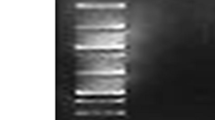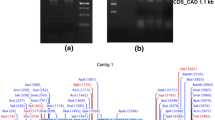Abstract
Two full-length hexokinase (HXK, EC 2.7.1.1) cDNAs, VvHXK1 with 1,413 bp and VvHXK2 with 1,458 bp were cloned from grape berries (Vitis vinifera L. Cabernet Sauvignon). VvHXK1 and VvHXK2 genes sequence from grape berries were deposited in GenBank under the accession number JN118544 and JN118545, respectively. The homology of the amino acid of VvHXK1 or VvHXK2 was very similar to ‘Pinot Noir’ grape HXK sequence, their similarties were 99.36 % and 98.97 %, respectively. More intuitive phylogenetic tree showed that the homology of amino acid sequence VvHXK1 with melon CmHXK1 was 86 %, and VvHXK2 homology with rice OsHXK3 was 83 %. The HXK proteins were successfully expressed in plasmid pET-30a (+) vectors in Escherichia coli BL21 (DE3) pLysS. The expressed proteins were purified using Ni-NTA agarose column and used to produce HXK1 antibody and conducted HXK protein blotting analysis. The results,suggested that one polypeptide band of about 51 kDa HXK protein can be detected in grape berries, HXK protein level was the highest during early grape berry development, but the lowest from 50d to 60d during development. Biochemical analysis of two hexokinase isozymes indicated that glucose was the optimal substrate of HXK, The isoelectric points of the two isozymes were 5.8 and 5.6, respectively. And the optimum pH was about 8.0. These results provide a substantial basis for the further studies of functions of grape HXKs to manipulate sugar content of grape berries.










Similar content being viewed by others
Abbreviations
- HXK:
-
Hexokinase
- IPTG:
-
Isopropyl-β-D-thiogalactoside
References
Bradford MM (1976) A rapid and sensitive method for the quantitation of microgram quantities of protein utilizing the principle of protein-dye binding. Anal Biochem 72:248–254
Cárdenas ML, Cornish-Bowden A, Ureta T (1998) Evolution and regulatory role of the hexokinases. Biochim Biophys Acta 1401:242–264
Cho JI, Ryoo N, Ko S, Lee SK, Lee J, Jung KH, Lee YH, Bhoo SH, Winderickx J, An G, Hahn TR, Jeon J (2006) Structure, expression, and functional analysis of the hexokinase gene family in rice (Oryza sativa L.). Planta 224:598–611
Claeyssen E, Wally O, Matton DP (2006) Cloning, expression, purification, and properties of a putative plasma membrane hexokinase from Solanum chacoense. Protein Expr Purif 47:329–339
Copeland L, Morell M (1985) Hexose kinases from the plant cytosolic fraction of soybean nodules. Plant Physiol 79:114–117
Dai N, Schaffer A, Petreikov M, Granot D (1995) Cloning of Arabidopsis thaliana hexokinase cDNA by complementation of yeast cells. Plant Physiol 108:879–880
da-Silva WS, Rezende GL, Galina A (2001) Subcellular distribution and kinetic properties of cytosolic and non-cytosolic hexokinases in maize seedling roots: implications for hexose phosphorylation. J Exp Bot 52:1191–1201
Famiani F, Walker RP, Tecsi L, Chen ZH, Proietti P, Leegood RC (2000) An immunohistochemical study of the compartmentation of metabolism during the development of grape (Vitis vinifera L.) berries. J Exp Bot 51:675–683
Fox TC, Green BJ, Kennedy RA, Rumpho ME (1998) Changes in hexokinase activity in Echinochloa phyllopogon and Echinochloa crus-pavonis in response to abiotic stress. Plant Physiol 118:1403–1409
Galina A, da-Silva WS (2000) Hexokinase activity alters sugar-nucleotide formation in maize root homogenates. Phytochemistry 53:29–37
Guglielminetti L, Perata P, Morita A, Loreti E, Yamaguchi J, Alpi A (2000) Characterization of isoforms of hexose kinases in rice embryo. Phytochemistry 53:195–200
Isla MI, Vattuone MA, Sampietro AR (1998) Hydrolysis of sucrose within isolated vacuoles from Solanum tuberosum L. tubers. Planta 205:601–605
Jang JC, Leon P, Zhou L, Sheen J (1997) Hexokinase as a sugar sensor in higher plants. Plant Cell 9:5–19
Juliana CP, Meyer LE, Machado LB, Oliveira MF, Galina A (2009) Reactive oxygen species production by potato tuber mitochondria is modulated by mitochondrially bound hexokinase activity. Plant Physiol 149:1099–1110
Koch KE (2004) Sucrose metabolism: regulatory mechanisms and pivotal roles in sugar sensing and plant development. Curr Opin Plant Biol 7:235–246
Laemmli UK (1970) Cleavage of structural protein during the assembly of the head of bacteriophage T4. Nature 227:680–685
Moore B, Zhou L, Rolland F, Hall Q, Cheng WH, Liu YX, Hwang I, Jones T, Sheen J (2003) Role of the Arabidopsis glucose sensor HXK1 in nutrient, light, and hormonal signaling. Science 300:332–336
Nir D, Michal KK, Marina P, Rana H, Ilan L, Bérénice R, Christophe R, Arthur A, Schaffer A, David G (2002) The tomato hexokinase LeHXK1 cloning, mapping, expression pattern and phylogenetic relationships. Plant Sci 163:581–590
Renz A, Stitt M (1993) Substrate specificity and product inhibition of different forms of fructokinases and hexokinases in developing potato tubers. Planta 190:166–175
Schnarrenberger C (1990) Characterization and compartmentation in green leaves, of hexokinases of different specificities of glucose, fructose, and mannose and for nucleoside triphosphates. Planta 181:249–255
Veramendi JU, Roessncr A, Renz L, Willmitzer RN (1999) Antisense repression of hexokinase 1 leads to an overaccumulation of starch in leaves of transgenic potato plants but not to significant changes in tuber carbohydrate metabolism. Plant Physiol 121:123–134
Wan SB, Wang W, Luo M, Huang WD, Yin JY, Zhan JC (2010) CDNA cloning, prokaryotic expression, polyclonal antibody preparation of the auxin-binding protein 1 gene from grape berry. Plant Mol Biol Rep 28:373–380
Wang XQ, Huang WD, Zhan JC (2005) Effects of weak light on the sucrose synthase in source leaves of nectarine trees (Prunus persica L. var. nectarine Ait.). J Hortic Sci Biotechnol 80:356–362
Wang W, Wan SB, Zhang P, Wang HL, Zhan JC, Huang WD (2008) Prokaryotic expression, polyclonal antibody preparation of the stilbene synthase gene from grape berry and its different expression in fruit development and under heat acclimation. Plant Physiol Biochem 46:1085–1092
Wiese A, Croner F, Sonnewald U, Deppner H, Lerchl J, Hebbeker U, Flugge U, Weber A (1999) Spinach hexokinase I is located in the outer envelope membrane of plastids. FEBS Lett 461:13–18
Yamamoto YT, Prata JD, Williamson M, Weddington DM (2000) Formation of a hexokinase complex is associated with changes in energy utilization in celery organs and cells. Physiol Plant 110:28–37
Zhang DP, Lu YM, Wang YZ, Duan CQ, Yan HY (2001) Acid invertase is predominantly localized to cell walls of both the practically symplasmically isolated SE/CC complex and parenchyma cells in developing apple fruits. Plant Cell Environ 24:691–702
Acknowledgments
This research was supported by the National Natural Science Foundation of China (Grants No. 30871698 and No. 31071764).
Author information
Authors and Affiliations
Corresponding author
Rights and permissions
About this article
Cite this article
Yu, F., Li, L.M., Yang, P.P. et al. Hexokinase from grape berries: its prokaryotic expression, polyclonal antibody preparation and biochemical property analyses. J. Plant Biochem. Biotechnol. 22, 324–334 (2013). https://doi.org/10.1007/s13562-012-0163-9
Received:
Accepted:
Published:
Issue Date:
DOI: https://doi.org/10.1007/s13562-012-0163-9




